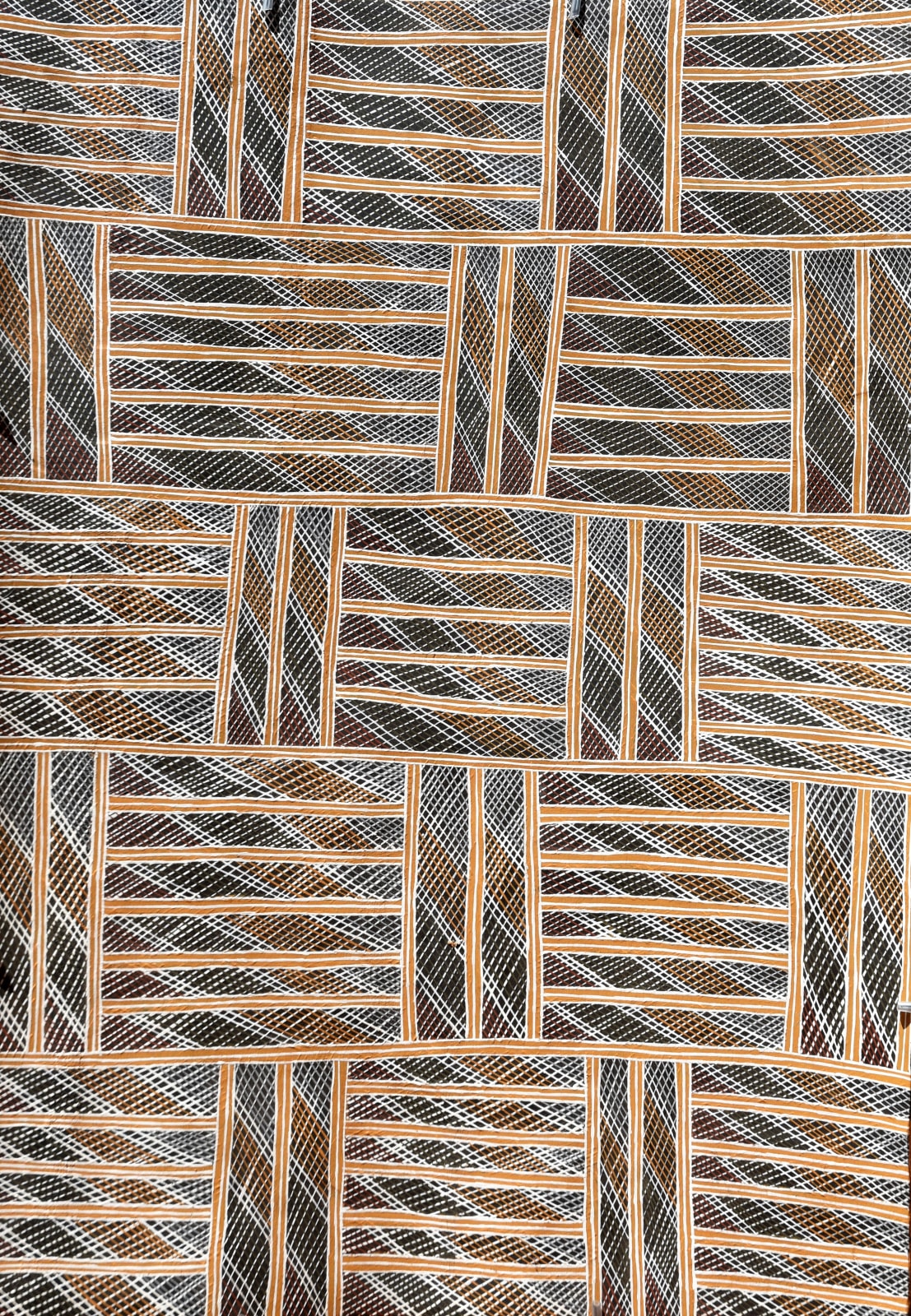Djurrayun Murrinyina Australian, Yolngu, b. 1974
Wukili, 2019
natural pigment on bark
51 x 28 cm
5812-19
The area of sea country belonging to the Djarrwark clan is known as Wukili. It is between Baraltja and Garrapara on Blue Mud Bay. During the time of the first...
The area of sea country belonging to the Djarrwark clan is known as Wukili. It is between Baraltja and Garrapara on Blue Mud Bay.
During the time of the first morning, the Dhuwa Waŋarr, or creator ancestors, the Djaŋ’kawu paddled their canoe Malili (paddles Matiny) into this country. They saw catfish Balwaltja and ‘sheridan’s threadfin’ Malmuŋa and sang them as Dhuwa totems associated with the special qualities of the saltwater country of Wukili.
The miny’tji (sacred clan design) represents the Djarrwark saltwater itself. The Dhuwa saltwater country is marked by the straight and parallel ribbons of miny’tji of the Djarrwark. It is read to be water affected by the Ancestral presence of the Djaŋ’ kawu Creators, the forebears of all Dhuwa people who laid down the law in the ancient past, including all the songs, dances, designs and deeds to land and water.
BARK PAINTINGS
This piece is made from stringybark (Eucalyptus Tetradonta) which is harvested from the tree in the late Wet Season (February - June). Ṉuwayak means bark. The bark is usually initially heated intensely over a fire and then laid down flat for some weeks. After the surface is sanded smooth a layer of red paint is usually the first to go down.
The paints used are earth pigments. The red (Meku), yellow (Gaŋgul) and black (Gurrṉan) are provided by rubbing rocks of these colours against a grinding stone and then adding water and PVA glue in small quantities. A new batch of paint is prepared or renewed every few minutes as it dries or is used up. After an outline of the composition is laid down the marwat or crosshatching commences. This is applied using a brush made of a few strands of straight human hair usually from a young woman or girl. The artist charges the marwat (brush) with the paint and then paints away from themselves in a straight line. Each stroke requires a fresh infusion of pigment.
The last layer to be applied is almost always the white clay or Gapan, which is made from kaolin, harvested from special sites. This also has water and glue added after being crushed into a fine powder. Artists will paint their own or their family’s clan designs or will create decorative pieces. Some decorative designs are: wayin (bird), guḏurrku (brolga), guya (fish), mäna (shark), bäru (crocodile), gunydjuḻu (lizard), dharpa (plant), boṉba (butterfly), miyapunu (sea turtle), djunuŋgayaŋu (dugong).
During the time of the first morning, the Dhuwa Waŋarr, or creator ancestors, the Djaŋ’kawu paddled their canoe Malili (paddles Matiny) into this country. They saw catfish Balwaltja and ‘sheridan’s threadfin’ Malmuŋa and sang them as Dhuwa totems associated with the special qualities of the saltwater country of Wukili.
The miny’tji (sacred clan design) represents the Djarrwark saltwater itself. The Dhuwa saltwater country is marked by the straight and parallel ribbons of miny’tji of the Djarrwark. It is read to be water affected by the Ancestral presence of the Djaŋ’ kawu Creators, the forebears of all Dhuwa people who laid down the law in the ancient past, including all the songs, dances, designs and deeds to land and water.
BARK PAINTINGS
This piece is made from stringybark (Eucalyptus Tetradonta) which is harvested from the tree in the late Wet Season (February - June). Ṉuwayak means bark. The bark is usually initially heated intensely over a fire and then laid down flat for some weeks. After the surface is sanded smooth a layer of red paint is usually the first to go down.
The paints used are earth pigments. The red (Meku), yellow (Gaŋgul) and black (Gurrṉan) are provided by rubbing rocks of these colours against a grinding stone and then adding water and PVA glue in small quantities. A new batch of paint is prepared or renewed every few minutes as it dries or is used up. After an outline of the composition is laid down the marwat or crosshatching commences. This is applied using a brush made of a few strands of straight human hair usually from a young woman or girl. The artist charges the marwat (brush) with the paint and then paints away from themselves in a straight line. Each stroke requires a fresh infusion of pigment.
The last layer to be applied is almost always the white clay or Gapan, which is made from kaolin, harvested from special sites. This also has water and glue added after being crushed into a fine powder. Artists will paint their own or their family’s clan designs or will create decorative pieces. Some decorative designs are: wayin (bird), guḏurrku (brolga), guya (fish), mäna (shark), bäru (crocodile), gunydjuḻu (lizard), dharpa (plant), boṉba (butterfly), miyapunu (sea turtle), djunuŋgayaŋu (dugong).
